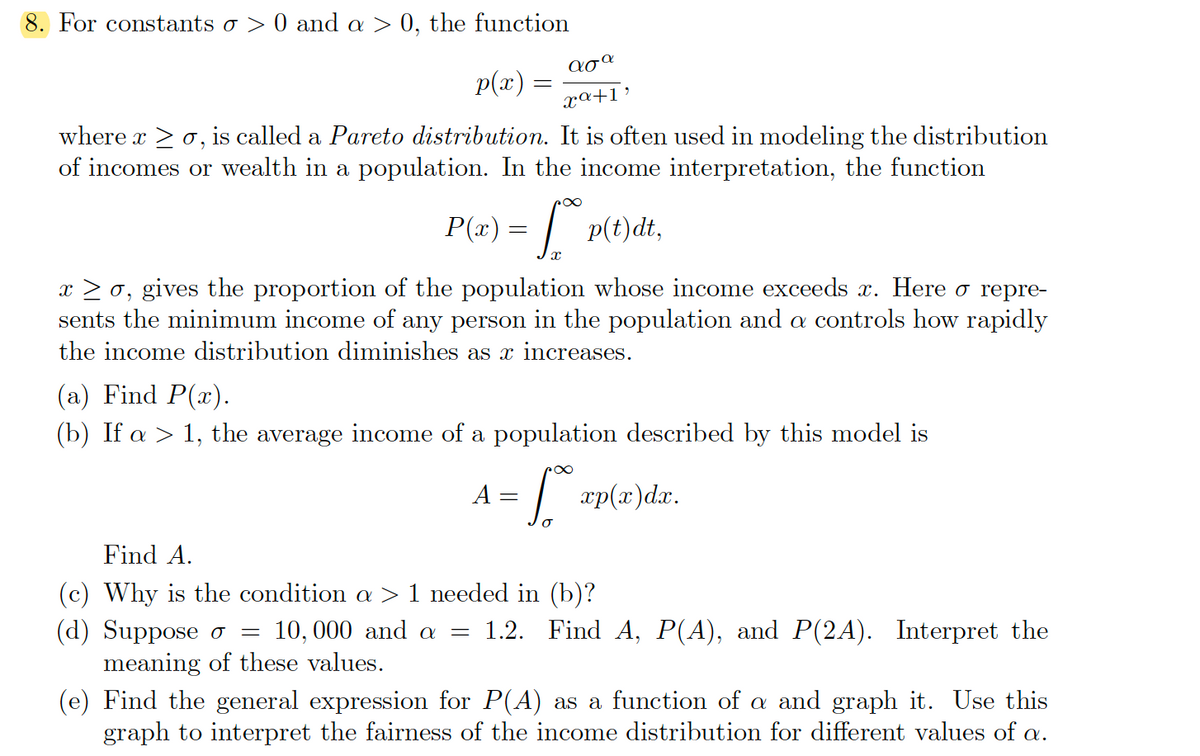For constants o > 0 and a > 0, the function aoª p(x) xa+1> where x > 0, is called a Pareto distribution. It is often used in modeling the distribution of incomes or wealth in a population. In the income interpretation, the function P(x) = p(t)dt,
For constants o > 0 and a > 0, the function aoª p(x) xa+1> where x > 0, is called a Pareto distribution. It is often used in modeling the distribution of incomes or wealth in a population. In the income interpretation, the function P(x) = p(t)dt,
MATLAB: An Introduction with Applications
6th Edition
ISBN:9781119256830
Author:Amos Gilat
Publisher:Amos Gilat
Chapter1: Starting With Matlab
Section: Chapter Questions
Problem 1P
Related questions
Concept explainers
Equations and Inequations
Equations and inequalities describe the relationship between two mathematical expressions.
Linear Functions
A linear function can just be a constant, or it can be the constant multiplied with the variable like x or y. If the variables are of the form, x2, x1/2 or y2 it is not linear. The exponent over the variables should always be 1.
Question
(d) Suppose = 10, 000 and = 1.2. Find A, P(A), and P(2A). Interpret the
meaning of these values.

Transcribed Image Text:8. For constants o > 0 and a > 0, the function
ασα
p(x) :
xa+1’
where x > o, is called a Pareto distribution. It is often used in modeling the distribution
of incomes or wealth in a population. In the income interpretation, the function
P(æ) = | p(t)dt,
x > 0, gives the proportion of the population whose income exceeds x. Here o repre-
sents the minimum income of any person in the population and a controls how rapidly
the income distribution diminishes as x increases.
(a) Find P(x).
(b) If a > 1, the average income of a population described by this model is
A =
xp(x)dx.
Find A.
(c) Why is the condition a > 1 needed in (b)?
(d) Suppose o
meaning of these values.
10, 000 and a
1.2. Find A, P(A), and P(2A). Interpret the
(e) Find the general expression for P(A) as a function of a and graph it. Use this
graph to interpret the fairness of the income distribution for different values of a.
Expert Solution
This question has been solved!
Explore an expertly crafted, step-by-step solution for a thorough understanding of key concepts.
Step by step
Solved in 3 steps

Knowledge Booster
Learn more about
Need a deep-dive on the concept behind this application? Look no further. Learn more about this topic, statistics and related others by exploring similar questions and additional content below.Recommended textbooks for you

MATLAB: An Introduction with Applications
Statistics
ISBN:
9781119256830
Author:
Amos Gilat
Publisher:
John Wiley & Sons Inc

Probability and Statistics for Engineering and th…
Statistics
ISBN:
9781305251809
Author:
Jay L. Devore
Publisher:
Cengage Learning

Statistics for The Behavioral Sciences (MindTap C…
Statistics
ISBN:
9781305504912
Author:
Frederick J Gravetter, Larry B. Wallnau
Publisher:
Cengage Learning

MATLAB: An Introduction with Applications
Statistics
ISBN:
9781119256830
Author:
Amos Gilat
Publisher:
John Wiley & Sons Inc

Probability and Statistics for Engineering and th…
Statistics
ISBN:
9781305251809
Author:
Jay L. Devore
Publisher:
Cengage Learning

Statistics for The Behavioral Sciences (MindTap C…
Statistics
ISBN:
9781305504912
Author:
Frederick J Gravetter, Larry B. Wallnau
Publisher:
Cengage Learning

Elementary Statistics: Picturing the World (7th E…
Statistics
ISBN:
9780134683416
Author:
Ron Larson, Betsy Farber
Publisher:
PEARSON

The Basic Practice of Statistics
Statistics
ISBN:
9781319042578
Author:
David S. Moore, William I. Notz, Michael A. Fligner
Publisher:
W. H. Freeman

Introduction to the Practice of Statistics
Statistics
ISBN:
9781319013387
Author:
David S. Moore, George P. McCabe, Bruce A. Craig
Publisher:
W. H. Freeman